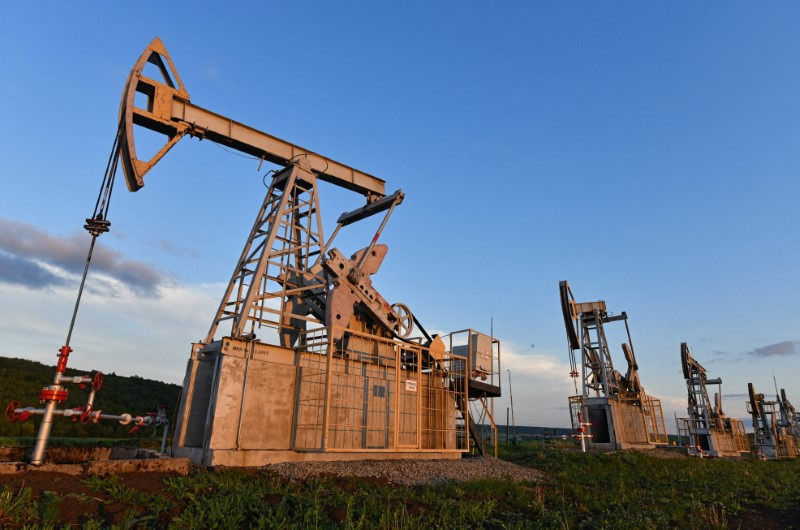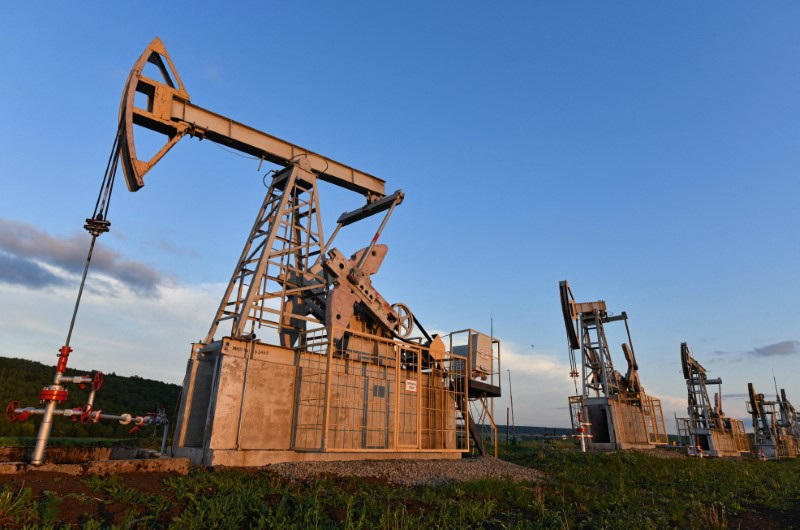Commodities
Oil falls 2% to end volatile week, focus on China demand concerns

By Shariq Khan
NEW YORK (Reuters) -Oil prices settled down nearly 2% on Friday, little changed on the week with below $80 a barrel, as investors tempered expectations of demand growth from top oil importer China.
Brent crude futures fell $1.36, or 1.7%, to settle at $79.68 per barrel. U.S. West Texas Intermediate crude futures declined by $1.51, or 1.9%, to $76.65.
Last week, Brent crude ended at $79.66 a barrel and WTI closed at $76.84.
On Thursday, data from China showed its economy lost momentum in July, with new home prices falling at the fastest pace in nine years, industrial output slowing and unemployment rising.
That has stoked worries among traders about a slump in demand from the top oil importer, where refineries sharply cut crude processing rates last month on tepid fuel demand.
The Organization of the Petroleum Exporting Countries on Monday cut its forecast for this year’s oil demand growth, citing softness in China. The Paris-based International Energy Agency also cited weak demand in China when it slashed its 2025 forecasts on Tuesday.
“It has been a volatile week in oil markets: on one hand you had fears of supply disruptions from a wider Middle East war, but on the other, slowing growth in China forced revisions of demand forecasts,” said Andrew Lipow, president of energy consultancy Lipow Oil Associates.
Oil futures rallied at the start of the week as traders braced for retaliation by Iran against Israel over the slaying of a Hamas leader in Tehran last month. But some of that risk was priced out because Iran has not struck yet, analysts at Commerzbank (ETR:) Research wrote on Friday.
“At least so far, supply disruptions have been more theoretical than actual,” said Brett Friedman, contributor for market data provider OptionMetrics. “That allows the market to focus on the demand side,” Friedman said.
A fresh round of Gaza ceasefire talks began on Thursday in Qatar. It has been paused until next week, with involved parties sending mixed signals on progress.
“Provided the situation in the Middle East does not escalate further, the oil price is likely to tread water,” the Commerzbank analysts said.
A string of data releases from the U.S. kept a floor under oil prices: retail sales beat analysts’ expectations, and fewer Americans filed new jobless claims last week, sparking renewed optimism around economic growth in the biggest oil market.

Oil prices could lack direction until the U.S. Federal Reserve decides whether to cut interest rates at its September meeting, independent oil analyst Gaurav Sharma said.
Low liquidity likely fed price volatility this week as many European and North American investors were still on holiday, UBS analyst Giovanni Staunovo said.
Commodities
Oil prices rise; U.S. crude inventories plunge, Russia-Ukraine truce eyed
Commodities
India’s Reliance to stop buying Venezuelan oil over US tariffs, sources say
Commodities
Oil prices climb on Venezuela supply worries

 Forex3 years ago
Forex3 years agoForex Today: the dollar is gaining strength amid gloomy sentiment at the start of the Fed’s week

 Forex3 years ago
Forex3 years agoUnbiased review of Pocket Option broker

 Forex3 years ago
Forex3 years agoDollar to pound sterling exchange rate today: Pound plummeted to its lowest since 1985

 Forex3 years ago
Forex3 years agoHow is the Australian dollar doing today?

 Cryptocurrency3 years ago
Cryptocurrency3 years agoWhat happened in the crypto market – current events today

 World3 years ago
World3 years agoWhy are modern video games an art form?

 Commodities3 years ago
Commodities3 years agoCopper continues to fall in price on expectations of lower demand in China

 Economy3 years ago
Economy3 years agoCrude oil tankers double in price due to EU anti-Russian sanctions

























